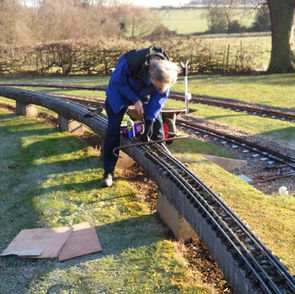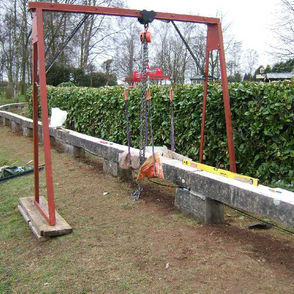High Level Tack Refurbishment,
Agreed at the January 2012 Board Meeting.
by Mike Bentley
For some time now there has been concern about the condition of the high level track. The cement in between the blocks and track base has deteriorated over successive winters to the extent that it was considered that the most sensible way forward was to strip and completely refurbish it. It is around 30 years since it was originally built and well before the ground level; the complete rebuild and extension of which was finished last year. Also like the ground level track, the signal cabling will be replaced and put into trunking rather than as now leaving the cabling dangling dangerously below the track base.
Mike Bentley has volunteered to head up the rebuild/refurbishment.
The following notice was sent to Club Members asking for volunteers.
"I have been asked to lead the renovation of the high level track project. As you can see we no longer have a usable high level track. Beams had to be removed ready for re-positioning. About a third of them will need to be removed. We feel movement is due to extreme heat / cold. Affected ones face south - I think. The track will all have to come off and be relayed with new sections in places. Please warn everyone that the track is not useable. We hope to have it back in use by Spring. Please contact Mike if can help him. He is in the club email /phone list"
January 12th 2012 we start the project
January 15th 2012
To clean up the concrete parts, we use a well bured bolster chisel. The pillar (no18 bit) and a top beam. All were cast FREE by the local quarry. Stuart called in every morning
going to work with his trailer and picked up a set, dropped the trailer off and on to work. If you look at the 30 years ago and picture 3rd down the page you can see the dough nuts- no jam type.
I am not sure but I think the dough nut is the correct way up as well. So the (no18) is sitting on the top of it. See picture on the 30 years you can just see the dough nut & a bit of wood.
22nd January 2012
25th January 2012
On Sunday the 25th I was delighted to be able to talk to Peter McMillian about the structure and planning of the raised level track. As he was part of the team that designed and built it he had original plans, measurements and structural details. This was most useful in planning the way forward with the project.
Having removed quite a few beams and some lengths of track we were able to check the stability of the concrete supports. One was found to rock so it was decided to expose it to investigate the cause. I had discovered that the top visible support was sitting on a doughnut ( being bolted to it) that was in turn sitting on a concrete slab. The problem was the bolt appeared to have become too long – or the mortar between the doughnut and the top support had crumbled.
It was decided to remove as much of the remaining mortar as possible fit spacers to level the block to put the bolt under tension. This done we put fresh mortar in and added concrete as a support in a ring around the structure. We will reinstate the grass- honest.
We can now consider re-instating the beams using similar materials to previous and done in such a way as to allow some lateral movement.
We were very lucky to be loaned an ‘A’ frame system by David Osborne – who even painted it. This will enable us to place the beams in position with ease. (Our poor chairman suffered having lifted them off by hand).
There will be lots to do and there are many questions to be answered but I am sure – with all the help and good will ( not to mention advice) it will be sorted.
Mike Bentley
Mike, assisted by John and Peter dug out the soil around the loose doughnut on the raised level track, and after re-alignment, re-concreted it back in position.
31st January 2012
A busy day today. Discussion with Bill and Mark regarding the signal cable runs and the decision to try to make use of original wiring. Bill then measured up for the length of trunking we would need. John filled in the excavation we made last week with frozen turf. Chris and I cut up lengths of DPC to cover the tops of the pillars before the beams were to go back in place. With lots of help the 'A' frame was put together complete with block and tackle and one by one the beams were cleaned of any remaining mortar and hoisted / lowered back in position. The 'A' frame worked very well in making the job safe and manageable.
The next job will be to level them up using shims before fixing them in place using mainly the original method.
Thanks to everyone that helped today.
7th February 2012
On Tuesday it was a day for taking stock of what was needed to be done and a bit of shivering. Close examination of the track has revealed large gaps in the rails, broken fishplates and flattened track. The hammering action of rolling stock going over big gaps in the track has squashed the piece of track landed on by the loco. This has happened in quite a few places. Some nuts bolts holding the fishplates has corroded. There are 20 nuts and bolts at each join of the track, having 31 joins that is a lot of 4 BA bolts to replace. The 16 beams that were removed and re-sited now need to be shimmed and bedded on mortar. The ‘A’ frame will be so handy. As will the water gauge that is being worked on by Dave and Alan. Next comes the keying areas, either side of the bolt, at the end of each beam that will need a strong material inserted to stop the sideways movement of beams and allow for some expansion and contraction due to heat and cold. Once this is done the track removed will be cleaned up with ends made good and drilled as necessary. These will then be screwed down before the next few lengths are removed. Having removed track the state of the joints on the beams will be revealed enabling joint repairs to be carried out , hopefully without lifting the remaining beams. It has been decided, with the help of Mark and Bill and the signalling team, to remove all the old signal wires and using the same method as used on the ground level system, put the cables in underground trunking. The signal posts will also be refurbished. More of this later. As you can see there is plenty to do but not that much can be done in freezing weather but I will try. Any offers of help would be very welcome.
14th February 2012
Thanks to John and Chris and other members for their help today. Two done thirteen to go. I am sure it will get quicker. It takes time to set levels especially as the top surface of the beams is not very level. We are working on a 2 mm difference in height for each beam. Hopefully get a couple more done on Sunday. Today the signalling team took up two signals for refurbishment. All old cable will be removed and all new cable carried in trunking buried as per ground level track. Glad we were able to get something done today after all the ice and cold.
28th February 2012
Today progress on levelling and setting beams has gone well. We now have 6 re-laid on shims and mortared in place. You will notice on the pictures that we have devised a temporary way of stabilising the ‘A’ frames by using two struts clamped in place. This worked well and made the job a lot safer. As before each beam was hoisted up and shims changed until the beam was at the correct height, level and stable. It was then lifted again and mortar applied, lowered and tamped. The water gauge, once we had correctly set it up, enabled us to work out the height that each beam must be when laid. This is written on each beam. Next Tuesday it is all hands to the pump to get as many of the other beams laid as possible, Your help would be greatly appreciated. Peter, John and I with lots of other bits of help from ‘passing persons’, had a productive day.
6th March 2012
Lots of help today from Garry Tyso, John Cope, John Rous, Chris Green and Peter Robinson. I was delighted to have so much help which made the day fun.
We have reached a pillar that is lower than the rest so we have had to use more packing. All is going to plan. May be one more good day will get the other five in place.
The next job will be to get the sections of track back in position and off the ground where they are vulnerable to possible damage.
13th March 2012
Tuesday was a good working day with sunshine to help us finish putting back the last beam. Help today was from Chris, Peter, John Cope and Vic.
Now we can start to relay the track that we took up and repair, were necessary, the pointing on the other beams making sure they are all stable.
3rd April 2012
8th April 2012 Easter Weekend
Just a few photos of Mike and Peter doing a bit of track work. They are sorting out the joint and what the plan of action to start replacing the track.
6th May 2012
Sunday was a good working day with sunshine to help us move some sleepers about Some have holes in so we can screw it all back down to the beams. We hope to get the new joint made this next Tuesday. Working to day on the track was Mike Peter and John Cope.
8th May 2012
We had a good day yesterday. With the help of Peter, John and Ron we actually finished putting the track back and connecting it up ready to run.
Pictures show the last short section being made up and fitted. Photograph shows the bending machine we used to match the curvature of the track.
Kindly loaned by our Chairman. Also can be seen is Bill pulling cables through for the new signalling system.
We have to put ballast between the sleepers, some remedial pointing to the beams on the rest of the track and make good a few joins.
22nd May 2012
Tuesday was a bust day for Peter, John and myself. Just at the end of the bend out of the tunnel we needed to repair a very bad joint in the rails. The rails being bent sideways and downwards with the wrong camber. Things change over time. We wanted to complete the job in the day so the track was useable for Saturday Steam Event.
The pictures show the problem track connection, work in progress, the section of new track inserted and the completed job.
We took the opportunity of moving rails to close large gaps before the new track was cut to length. The track is useable thanks to much hard work in the sun.
Next job is to is put in cement and ballast.
Bill and his team managed to get the signals working on two sections of track.
This is not quite the end of this project as they spend many weeks filling in between the sleepers






































































